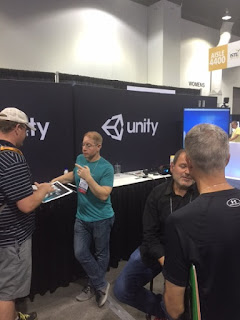In last week's post, we introduced a recent Estonian study claiming that 3D cinema can contribute to headaches, and by association, this would hold true for experiencing virtual reality. In confronting this concern head on, I interviewed some international medical experts in the field of 3D, stereoscopic, and virtual reality vision. Find their analyses below:
Dr. Simonson
Dr. Simonson
Dr. Jennifer
Simonson, clinical director of the Boulder Valley Vision Therapy center and
Senior Research Optometrist for Gerull Labsan
(OD, FCOVD) is an expert in using 3D to diagnose and treat vision
disorders (and headaches). She explains the 'headache' problem in this way:
"This study takes in to account eyesight, but not vision. The key difference between 3D and 2D is the amount of coordination required of the eye muscles to align and focus the eyes at multiple distances. It is also more cognitive work in the brain for processing the difference in information presented to each eye to combine two different images into 3D perception. Stereopsis - depth perception - causes common 3D Vision Syndrome symptoms such as headaches, blurred vision and tired eyes. When a person has difficulty seeing 3D in a movie theater, it is commonly due to a vision problem with the coordination of the eyes. A normal movie is viewed on the screen, but in a 3D movie, the images appear to float off of the screen. Even with normal eyesight, if there is a difficulty with tracking, eye teaming, or focusing a person will be symptomatic with 3D Vision Syndrome."
Dr. Simonson
concludes: “It may not be the media itself, but the visual dysfunction which
contributes to headaches.”
Dr. Sheedy
That brings us to Dr.
Jim Sheedy ( OD, PhD.), Director of the Vision Performance Institute at
Pacific University, and an internationally recognized researcher. Dr. Sheedy
worries about sample size, and he also points to vision disorders as the
culprit, not the 3D stimulus itself:
“The findings presented in the article by Braschinsky et al., concerning 3D Cinema and Headache, cannot be conclusive because of the poor response rate of 21.6% (1293 respondents of 6000 questionnaires distributed). Despite this shortcoming, the results are interesting. The subjects were asked only about the symptom of headache. We know that subjects with disorders of the visual system have symptoms such as eyestrain, double vision, blurred vision, and others related to the eyes. The subjects in the study by Braschinsky et. al. were not given opportunity to differentiate these symptoms from those of headache."
Dr. Sheedy concludes:
“The results are those that would be
expected on the basis of vision disorders and the symptoms they cause.”
Dr. Maino
Dr. Dominic Maino
(OD, MEd, FAAO, FCOVD and Professor,
Pediatrics/ Binocular Vision, Illinois College of Optometry/Illinois Eye
Institute Distinguished Practitioner, National Academies of Practice, Leonardo
da Vinci Award of Excellence in Medicine) offered his view in more detail,
wondering about the five main points of the Estonian study:
1.) Can 3D movies provoke headaches? Dr. Maino explains:
“I found it interesting that the reviewer did not say 3D movies actually caused the headache, as was often stated in earlier articles on this topic. Current research indicates that a faulty binocular vision system (vergence (eye teaming), accommodation (focusing), and oculomotor (eye movement)) dysfunction appears to be etiology of the headache when viewing a 3D stimulus.”
2.) Do individuals who view 3D movies report
headache during or after the movie 1.61 times more often than 2D movie viewers?
Dr. Maino concurs:
“Those with binocular vision dysfunction are not usually adversely affected by 2D movies, so this finding should come as no surprise. “
3.) Are the people at risk are mostly younger?
Again, Dr. Maino agrees:
“Younger populations typically have a higher rate of functional vision problems.”
4.) Are 3D movie visitors with a previous
history of headaches 4.17 times more prone to get a cinema-induced headache?
Dr. Maino suggests:
“Those with a history of headaches may also have undiagnosed vision problems as their non-3D movie related head pain.”
5.) Is risk the highest for persons with a
history of migraine headaches? Dr.
Maino explains:
“Migraine headaches can have many different triggers. These triggers can include stress, consumption of different foods and how light is perceived (e.g. flickering) by the individual. A dysfunctional visual system is known to cause stress as well. Also those who experience migraines may just be more in tune and sensitive to all head pain no matter the etiology.”
Dr. Maino, in
concluding, recommended that readers pursue more information on this topic by
exploring the public health report issued by the American Optometric
Association: 3D in the Classroom (http://aoa.uberflip.com/i/203445-3d-in-the-classroom ).
He also recommended that folks having difficulty seeing 3D cinema find doctors
who can help by going to the College of Optometrists in Vision Development
website (COVD.org) or the American
Optometric Association website (AOA.org).
Next week I will provide some of my own thoughts and conclusions on this matter...
Next week I will provide some of my own thoughts and conclusions on this matter...













